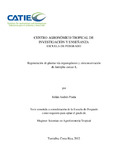| dc.contributor.author | Prada, Julián Andrés | |
| dc.date.accessioned | 2014-10-18T03:03:14Z | |
| dc.date.available | 2014-10-18T03:03:14Z | |
| dc.date.issued | 2012 | es_ES |
| dc.identifier | 387493 | es_ES |
| dc.identifier.uri | https://repositorio.catie.ac.cr/handle/11554/3767 | |
| dc.identifier.uri | http://orton.catie.ac.cr/repdoc/A10265e/A10265e.pdf | es_ES |
| dc.description | Tesis (M. Sc) -- CATIE, Turrialba (Costa Rica),2012 | es_ES |
| dc.description.abstract | El objetivo fue contribuir a la multiplicación vegetativa de Jatropha curcas L. a partir de la regeneración de callos organogénicos, segmentos nodales y a su conservación mediante la crioconservación de semillas y embriones cigóticos. Con esta investigación se pudo constatar que la propagación in vitro de J. curcas aún encierra limitaciones, asociadas principalmente al desarrollo de los brotes que dificulta la multiplicación y el enraizamiento de los mismos, haciendo difícil la transferencia de las plantas a condiciones de invernadero y suelo. Sin embargo, también una gran diversidad de respuestas posiblemente relacionadas a las diferencias en el genotipo. Con respecto a la crioconservación, este estudió permite hacer aportes al conocimiento de las semillas y embriones cigóticos de esta especie y su comportamiento durante la congelación en NL. Aunque el uso de la técnica de vitrificación de embriones cigóticos no permitió ninguna señal de sobrevivencia después de la congelación en NL, los resultados graduales de sobrevivencia observados en cada una de las fases previas a la inmersión en NL, permiten ampliar el conocimiento sobre la tolerancia de estos embriones a las diferentes sustancias crioprotectoras y sus concentraciones y su efecto durante la congelación. The objective of this research was to contribute to the vegetative multiplication of Jatropha curcas L. from the regeneration of callus organogenics, nadal segments and its conservation through cryopreservation of seeds and embryos zygotic. Through this research, it was possible to verify that the J. Curcas in vitro propagation encloses limitations mainly related with the development of shoots These limitations not only make difficult the multiplication and rooting of the shoots making difficult the transfer of the plants to greenhouse and soil conditions. However, also these ones present a variety of answers relating to genotype differences. Regarding to cryopreservation, this investigation makes contributions to the knowledge about seeds and zygotes embryos of this specie and the behavior of these ones during the freezing process in LN. Even though, the use of the zygote embryos vitrification technique did not permit a survival signal after freezing in LN, the gradual results of survival observed during the different stages before the immersion in NL allowed to expand the knowledge in regards to the tolerance of these embryos to the different cryoprotective substances and levels of concentration, and its effects during the freezing process. | es_ES |
| dc.language.iso | es | es_ES |
| dc.publisher | CATIE, Turrialba (Costa Rica) | es_ES |
| dc.subject | JATROPHA CURCAS | |
| dc.subject | REGENERACION VEGETAL | |
| dc.subject | REGENERACION IN VITRO | |
| dc.subject | BROTES | |
| dc.subject | MICROPROPAGACION | |
| dc.subject | CRIOPRESERVACION | |
| dc.subject | ORGANOGENESIS | |
| dc.subject | SECADO | |
| dc.subject | CONGELACION | |
| dc.subject | CONSERVACION DEL GERMOPLASMA | |
| dc.subject | METODOS ESTADISTICOS | |
| dc.title | Regeneración de plantas vía organogénesis y crioconservación de Jatropha curcas L. | es_ES |
| dc.type | Tesis de maestría | es_ES |
| dc.identifier.publication | Turrialba (Costa Rica) | es_ES |


